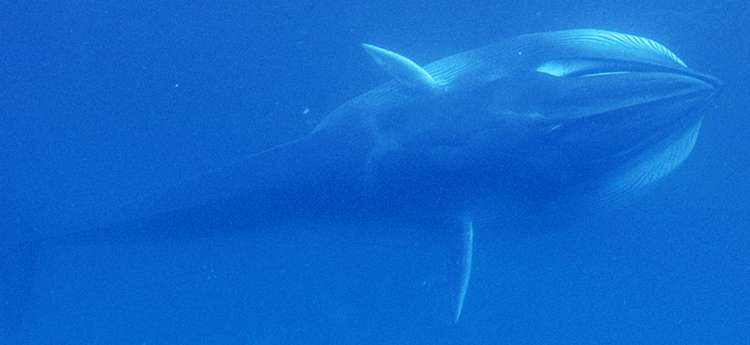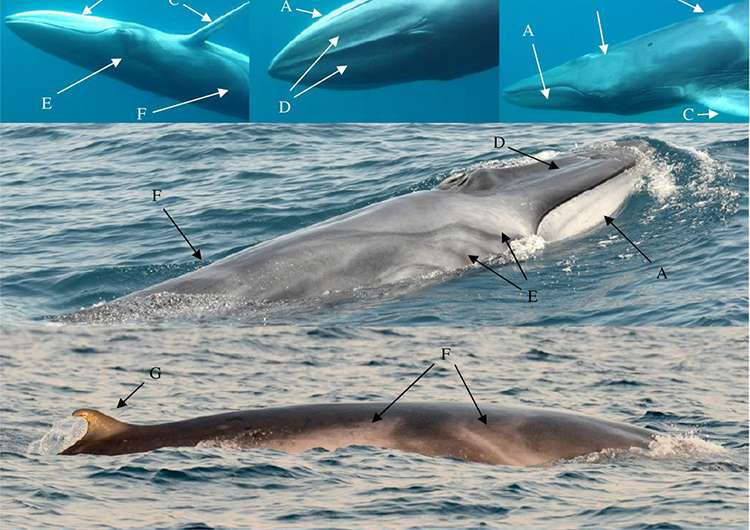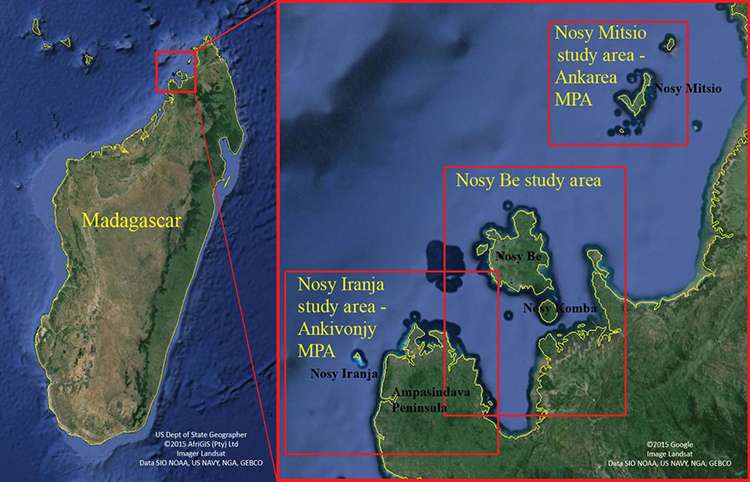New study provides first field observations of rare Omura's whales

An international team of biologists has made the first-ever field observations of one of the least known species of whales in the world—Omura's whales—off the coast of Madagascar.
In a paper published October 14, 2015, in the Royal Society Open Science journal, the researchers describe the whales' foraging and vocal behaviors, and habitat preferences in the shallow waters of coastal Madagascar.
For many years, these marine mammals were misidentified as Bryde's whales due to their similar appearance—both are small tropical baleen whales with comparable dorsal fins, though Omura's are slightly smaller in size and have unique markings with a lower jaw that is white on the right side and dark on the left.
In 2003, using genetic data from samples obtained from old whaling expeditions and a few strandings in the western tropical Pacific, scientists determined Omura's whales were actually a distinct species. But there had been no confirmed records of sightings in the wild and little else has been known about the elusive species until now.
"Over the years, there have been a small handful of possible sightings of Omura's whales, but nothing that was confirmed," says lead author Salvatore Cerchio, who led the research while at the Wildlife Conservation Society. He is now at the New England Aquarium (NEAQ) and a guest investigator at the Woods Hole Oceanographic Institution (WHOI). "They appear to occur in remote regions and are difficult to find at sea because they are small—they range in length from approximately 33 to 38 feet—and do not put up a prominent blow."

So little is known about Omura's whales that scientists are unsure how many exist or how rare the species is.
"What little we knew about these whales previously came primarily from eight specimens of Omura's whales taken in Japanese scientific whaling off the Solomon and Keeling Islands and a couple strandings of dead animals in Japan," Cerchio adds. "This is the first definitive evidence and detailed descriptions of Omura's whales in the wild and part of what makes this work particularly exciting."
When Cerchio and his colleagues, who have been conducting field research on marine mammals off the northwest coast of Madagascar since 2007, first spotted an Omura's whale in the area in 2011, they too believed it was a Bryde's whale.
"From the little information on their habitat and range, Omura's whales were not supposed to be in that part of the Indian Ocean," Cerchio says.
After moving study areas in 2013, the sightings became more frequent and the team noticed the distinct markings— unique asymmetrical pigmentation on the head— that led them to believe the whales might be Omura's whales.

Over a two-year period, the researchers observed 44 groups and were able to collect skin biopsies from 18 adult whales. The samples were then sent to coauthor Alec Lindsay at Northern Michigan University who performed the DNA analysis that confirmed the whales' species.
The research team also observed four mothers with young calves. Using hydrophones, they recorded song-like vocalizations that may indicate reproductive behavior.
Cerchio will return to the field in November to do further study on the whales' vocalizations, behavior and population characteristics. He also hopes to expand the research area in future studies of Omura's whales, working with colleagues at WHOI to deploy Digital Acoustic Recording Tags (DTAGS) and to study the species in other parts of its range.
Cerchio hopes to produce the first estimate of abundance for any population of Omura's whales with the work off Madagascar. So far, the team has catalogued approximately 25 individuals through photographic identifications.
Journal information: Royal Society Open Science
Provided by Woods Hole Oceanographic Institution


















